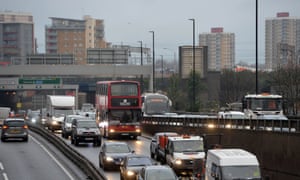A group of sixth formers are talking about street play, hide-and-seek and football – and about how cars impact the way they use local spaces.
“I have good memories of playing out,” says 17-year-old Sajidul Islam. “Big games of football with all my friends.” He thinks young people should be asked more often what they like about their neighbourhoods. “But I think they prefer to ask people with degrees.”
His classmate Ahona Zaman describes her journey to school, walking through a dark underpass beneath a dual carriageway. “I love cycling but it’s too dangerous.”
These teenagers in Poplar, east London, are growing up in an intensely urban neighbourhood. Low-rise houses, brightly painted shops and cramped parks push up against the constant hum of the A12. The streets are boxed in by major roads, and cranes and towers fill the skyline.
Zaman, Islam and their classmates are gathered in this classroom to work on a radical project; a collaboration with architect Dinah Bornat that aims to bring the voices of young people into the planning process.
Bornat is a mayor’s design advocate to mayor of London and an advocate of child-friendly design. She is here at the invitation of the local housing association, Poplar Harca, and developers at the outset of a regeneration plan for the local area, including 1,000 new homes on the nearby Aberfeldy estate. Underpinning her work, which is based on years of speaking to children about their neighbourhoods, is the belief that streets designed with young people in mind will put pedestrians firmly above car users.
Her youth-led approach is a growing influence on developers and architects, and she has just helped create a free to use youth engagement toolkit, Voice, Opportunity, Power. She hopes it will be part of a revolution, encouraging developers and community groups to give young people a voice in the debates taking place all over the country about issues such as low-traffic neighbourhoods.
In Poplar, Bornat wants to help bring about radical change. “Children are being driven to school because sliproads to the dual carriageway are crossing through their residential streets and it isn’t safe to walk.
“Young people can’t vote and they don’t pay taxes but don’t we want to know what they think? Too often we focus on negative issues to do with young people and we don’t think about their happiness and joy.”
In a survey for the project 89% of 16- to 18-year-olds said they had never been asked their opinion about changes in their neighbourhood.

Bornat points to the increasingly heated debate over low-traffic neighbourhoods as an example. “Has anyone asked young people what they think? If consultation letters go through doors they will be opened by adults. We need to go and find young people and actually ask them how they use space and what they want to do in it.”
She starts by asking the sixth formers how they use space around them. “Where do you like to play or hang out with your friends? We think you guys are the experts when it comes to what we call ‘the public realm’.”
“Nobody asks us, we are just kids,” says 17-year-old Fathine Quaium.
But these are well-informed kids, studying geography, including the impact of the regeneration that they can see taking place around them.
They know that adults are arguing about how to use roads, and they are looking at all sides of the arguments.
Nafisa Ahmed, 18, says: “I live right next to a main road and I think the road closures, the cycle lanes, it’s good – it pushes people away from driving, doesn’t it? And it helps the environment.” Her friends politely disagree. Ria Solanki, 17, says: “I think it’s worse for traffic, it just sends it another way.”
Thom Palser runs the Spotlight youth project attached to the school and grew up here. He wants developers to use spaces like his to link up with young people. “When they open up and say what they really think they have so much to say. These young people care about their whole community, they see themselves as part of the wider East End.”
The project takes place against a rapidly changing backdrop, with new political enthusiasm for traffic reduction. Last week transport secretary Grant Shapps announced GBP175m for low traffic neighbourhoods, and this week the prime minister’s 10-point green industrial revolution includes the aim of promoting public transport, cycling and walking.
Bornat is optimistic about the growing willingness in the industry to listen to young people. “I am getting calls from leading architects and developers, local authorities, housing associations … when I speak to them they are excited about this approach. They get it, if you listen to young people you end up with better places to live.”